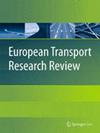基于临界维数的环形交叉路口近碰撞概率检测框架
IF 4.2
3区 工程技术
引用次数: 0
摘要
背景预防致命交通事故实现“零愿景”是社会面临的挑战。从视频记录的交通数据中收集关键事件对于更好地了解关键情况如何以及在何种情况下演变具有重要价值。确定的行为模式和衍生的基础设施措施不仅有助于提高驾驶安全性,还有助于成熟的自动驾驶功能(adf),使自动驾驶车辆更像人类驾驶和互动,特别是在具有挑战性的情况下。开发adf的一个缺陷是依赖于合成的模拟交通场景。本文提出了一种新的基于概率的框架,允许基于解释风险的两个维度来测量临界C(d)的程度:严重性(delta-v)和接近性(距离)。结果将该指标应用于环形交叉路口的实际数据。对其进行了初步评估,采用了一种将第二辆车的反应考虑在内的新方法,以及一种实际应用,显示了交通专家的感知风险与度量之间的潜在相关性。量化每个收集到的真实交通场景的风险,可以进一步在更可靠和重要的场景(如近碰撞)中测试adf。本文章由计算机程序翻译,如有差异,请以英文原文为准。
Criticality dimension-based probabilistic framework to detect near crashes in a roundabout
Abstract Background Preventing fatal traffic accidents towards Vision Zero is a challenge for the society. The collection of critical events from video recorded traffic data is of essential value for a better understanding on how and under what circumstances critical situations evolve. Identified behavioral patterns and derived infrastructural measures cannot only help to make driving safer, but also help to mature automated driving functions (ADFs) to make automated vehicles drive and interact more like humans especially in challenging situations. One flaw when developing ADFs is the dependency on synthetic simulated traffic scenarios. Method In this paper, a novel probability-based framework is proposed allowing to measure the degree of criticality C(d) based on two dimensions explaining risk: severity ( delta-v ) and proximity (distance). Results This metric is applied on real data of a roundabout. An initial evaluation of it was conducted using both a novel proposed method that takes the reaction of the second vehicle merged into account, and a practical application that shows a potential correlation between the traffic expert's perceived risk and the metric. Conclusion Quantifying risk on each of the collected real traffic scenarios makes testing ADFs possible in further more reliable and significant scenarios like near-crashes.
求助全文
通过发布文献求助,成功后即可免费获取论文全文。
去求助
来源期刊

European Transport Research Review
Engineering-Mechanical Engineering
CiteScore
9.70
自引率
4.70%
发文量
49
期刊介绍:
European Transport Research Review (ETRR) is a peer-reviewed open access journal publishing original high-quality scholarly research and developments in areas related to transportation science, technologies, policy and practice. Established in 2008 by the European Conference of Transport Research Institutes (ECTRI), the Journal provides researchers and practitioners around the world with an authoritative forum for the dissemination and critical discussion of new ideas and methodologies that originate in, or are of special interest to, the European transport research community. The journal is unique in its field, as it covers all modes of transport and addresses both the engineering and the social science perspective, offering a truly multidisciplinary platform for researchers, practitioners, engineers and policymakers. ETRR is aimed at a readership including researchers, practitioners in the design and operation of transportation systems, and policymakers at the international, national, regional and local levels.
 求助内容:
求助内容: 应助结果提醒方式:
应助结果提醒方式:


